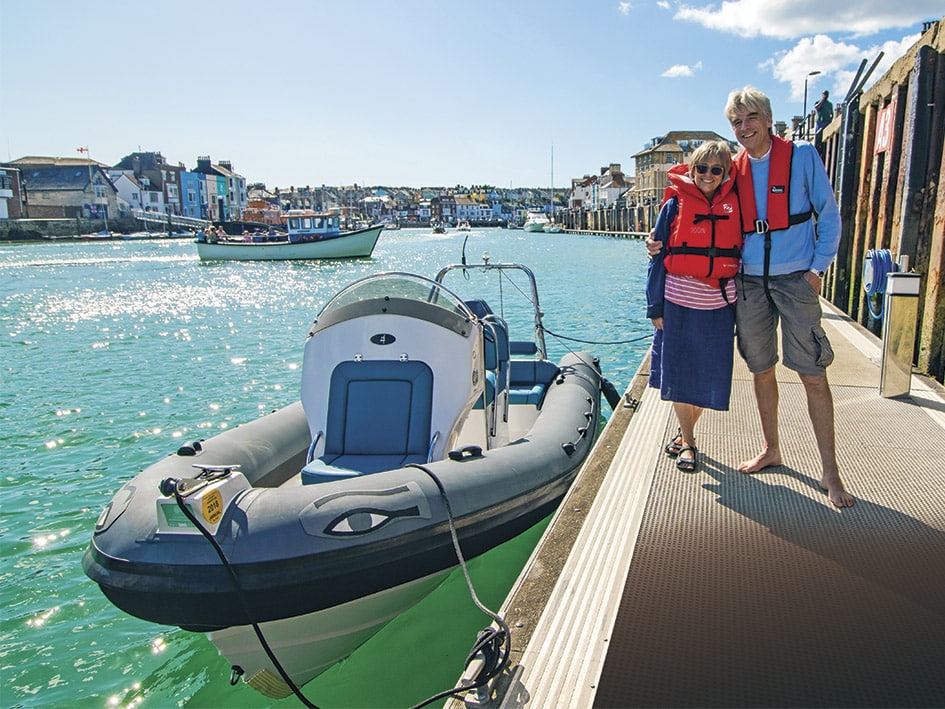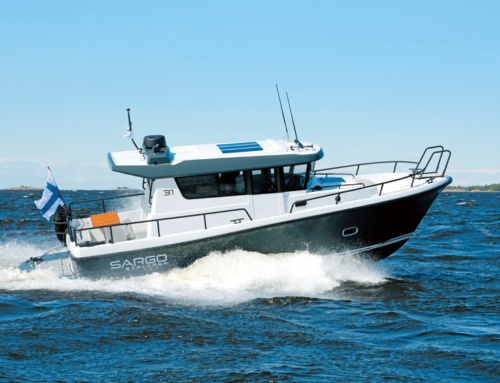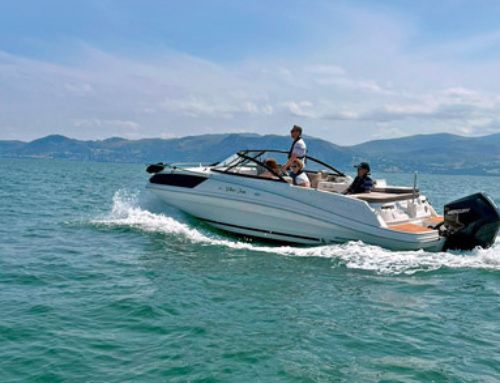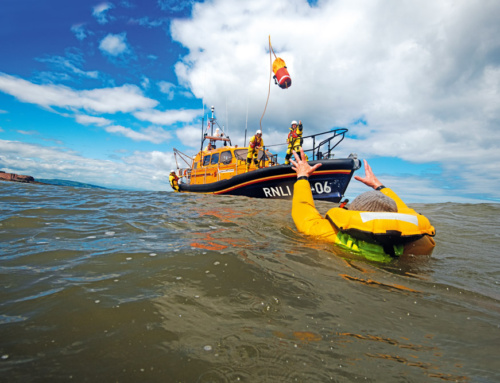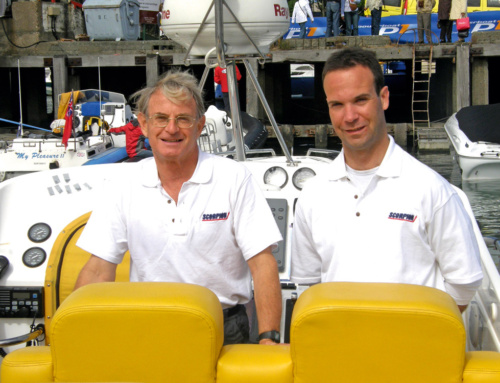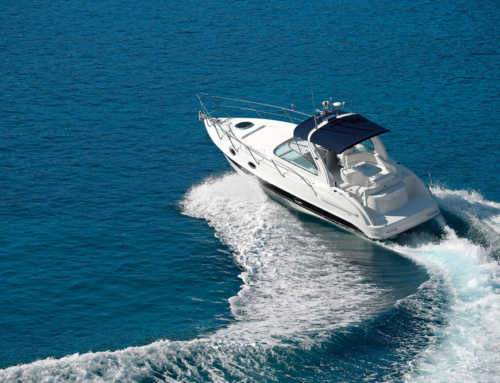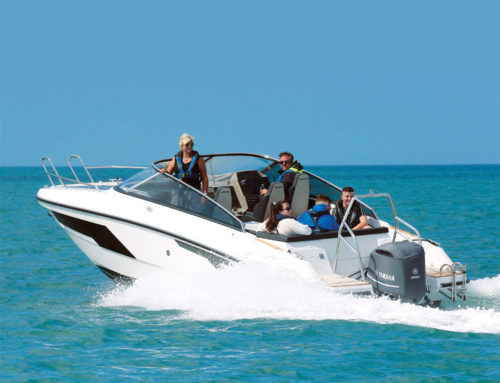Owning a boat for the first time can be both an exhilarating and challenging experience. Julian Boardman recounts some of the highs and lows he shared with his wife Chrissy as they dipped their toes in the waters of the high seas …
Cast your mind back, if you are able, to the days when you did not own a boat, when you did not need to concern yourself with tides or weather forecasts, marinas or slipways, or indeed anything much to do with the wonderful domain of water.
This is where Chrissy (my other half) and I were a couple of years ago. Quite by chance, a couple of years ago, we were invited by a lovely retired chap to go with him as he was ‘thinking of taking the boat out tomorrow’; this was on the Isle of Lewis (Outer Hebrides). We had no idea what ‘the boat’ was, but it turned out to be a RIB and we had a fabulous day exploring some small islets and seeing, among other things, seals and some quite scary jellyfish (Chrissy scares quite easily with jellyfish and indeed seaweed, but these were the real McCoy). Chrissy and I are both in our late fifties, with children now married, and therefore at a moment in our lives where we might look to do something different.
Buying our boat
This whetted our appetite, and at the Southampton Boat Show in 2016 we took the plunge and ordered a 5.5m RIB from Ribeye. Looking back now, we didn’t do all that much physical research, instead preferring Internet surfing. The boat show was the only place we did a sea trial (of the Ribeye and one other make). But Ribeye made a good job of making us feel special, and we did rather fall in love with the 5.5m, especially the ability to choose the seating layout. We liked the fact that, although small, it did have what you might call all the basics: radio, GPS, chargers for phone/electric pump etc. Realising that we had a lot to learn and that we were starting from a very low base (we had done some windsurfing and kayaking in our time but no more than that), we booked courses for RYA Powerboating Levels 1 and 2 and did some reading.
I imagined that the Powerboating course would be all about controlling the boat at great speed (well, 25 knots anyway). But of course, it is really all about safety ‒ as it should be. We found out, for example: that steering a boat around a marina, even in pretty light winds, can be surprisingly challenging, with plenty of opportunity to bump into other people’s boats; that there is no brake; that it is quite easy to run over the ‘man overboard’ buoy (Chrissy has since said that if I am ever the man overboard she will stop the boat and wait for me to swim to it ‒ not encouraging!); that you don’t just say ‘hello’ into the VHF radio and see if anyone answers; and that we needed to buy a new car as the one we had was not up to the job of towing.
Nevertheless, we passed and in due course took delivery of the RIB in April 2017. Partly to keep costs down, we are keeping the RIB on a trailer. We originally planned to store it in our back garden, which is a reasonable size, but it is easy to underestimate how long a car-trailer combination can be. I had worried beforehand about the width (we had some fairly tight gateposts to negotiate), but it had not occurred to me how much space we would need just to turn around and come out again. Getting to the back garden probably took an hour (because of the narrow gateposts and a ‘wiggle’ you have to do just to get past the house). Getting out again took about two weeks. It involved burning a clutch out (on the new car we had just bought) and in the end getting help from a contact at Portland who had a much better 4WD than us and the confidence to push the end of one inflatable tube hard against our kitchen window with no thought of it breaking. He was brilliant.
Needless to say, once we got it out of the back garden, it was off to the trailer park, never to return, and so we quickly got a lot of practice launching and recovering on the main slipway at Portland.
First outings
Since then, in gaining experience, we have been (using the trailer) on trips to:
Kimmeridge (notable event: if you fail to secure the manual winch properly when pulling the boat out of the water the boat simply falls off the back of the trailer as you drive away [well, it was dark and there was a man about to lock the gates to the slipway] ‒ unquestionably our ‘least finest hour’ with the boat);
Milford Haven (notable event: being told by a local fisherman after we had been out around Skomer Island that doing that trip was ‘as brave as *!*!’ ‒ a bit disconcerting as we had not thought there to be much danger);
Dartmouth/River Dart (where nothing went wrong 😊);
Most recently Jersey, about which you can read more below.
Jersey
Chrissy spied a gorgeous shot of Les Ecréhous and Les Minquiers in PBR magazine. ‘That’s pretty. Can we go there?’ As overall I am the more enthusiastic one, I did not want to sound discouraging, especially when an Admiralty set of maps of the Channel Islands appeared by my bedside. So, having discarded the idea of cruising to the Channel Islands from home, we explored taking the RIB on the fast ferry from Poole. Following a conversation with a lovely lady about the maximum length of the boat and the car, it seemed possible. Having thought about the height of the boat and our garage, we were confident about the measurements. Rookie mistake number one – I woke in the middle of the night and thought: ‘I know the height of the boat off the trailer but not on it.’ Hmmm. Off we went to the boatyard with a spirit level and a tape measure, thinking: ‘Are the VHF antenna and night light removable before we knock them off as we drive onto the ferry?’ Hmmm. It became obvious that it was a close-run thing and it did depend where Puffin was parked in the boatyard, where a slight slope acted in our favour.
So back on the phone to Condor Ferries with a conversation along the lines of: ‘So this 2.25m maximum – I suppose there is a bit of give and take if you are quite near the max?’ ‘No, sir, this is the absolute max.’ What to do? In the end, we convinced ourselves it was going to be OK – Chrissy in particular not being remotely worried about this, claiming that the limit probably only really referred to one ventilation duct that one should be able to miss … until we arrived on the day at the check-in where there is a very solid (and to me, looking from afar, not entirely horizontal) bar that you must get underneath to progress to the boarding zone. At this point, Chrissy did a 360 from ‘it will be fine’ to ‘there is no way we are getting under that’. An official approached us with a portable measuring stick, followed by a second official who pronounced that we were indeed too tall. The second one did give us a sideways wink and agree that we might be able to let some air out of the tyres if necessary. I persuaded him to let us try anyway, and Chrissy, who is somewhat vertically challenged, climbed a bit of railing to watch while a small crowd of onlookers oohed and aahed as we proceeded gingerly forwards and indeed successfully under the bar. A first for the limbo-dancing RIB!
All good, then, and off to Jersey, where we checked in at the marina, parked in the wrong boat park overnight, explored the showers and car parking, tried to understand how one got in and out of a tidal marina, and set off for the campsite.
The next thing we discovered is that most people arrive at the marina by boat, not car. If we had thought about it, this would appear to be obvious. But we hadn’t thought about it. The marina staff (Jersey Marinas) were delightful, if rather thoughtful, about the predicament of having to find somewhere to launch and somewhere to store a trailer for a boat that was not registered with Jersey Port Authority. This caused quite a few conversations between men who huddled together giving us assessing glances. In the end, they decided it was OK to let us use the local fishing industry slipway, which was both long and steep and had a flat portion in the middle for a period of a couple of hours off mid-tide. Someone more knowledgeable than me will know why this was a good idea. In any case, it provided good reversing practice with a heightened sense of expectation caused by the very sizeable drop to port.
Now, we had been well warned by the PBR article and various friends about the tides around Jersey. But it is one thing to read and another to experience. This became obvious to us as we prepared to launch towards the bottom of the slip, only to see the tide seemingly going out before our very eyes. We had to reverse further down the slip to catch up and then launch quickly. We changed our normal roles as Chrissy did not fancy negotiating the long slipway and somewhat tight trailer park, so I pushed her off with instructions to reverse straight back as I prepared to drive car and trailer away. The reversing did not last long, however, as the boat went back about 20 feet and then proceeded to return towards the slipway at an increasingly sideways angle. ‘Are you reversing, my love?’ is the polite version of my question, which was answered with ‘I am reversing’ as a reply that was about as unanswerable as it was untrue. I finished up wading in up to my waist in a bit of a panic and in my normal clothes and manually turning the RIB around. Chrissy insists she had it in hand. Another unanswerable comment. Fortunately going forward proved much more straightforward and all was well.
The next days were spent gradually increasing our knowledge and confidence in and around the port. The marina has a submerged wall at the entrance to prevent it drying out at low tide and accordingly is open roughly six hours on, six hours off, so you have to plan well ahead to avoid being stuck inside or outside the harbour. It turns out there can be a bit of a queue to exit as closing time approaches, and a queue to get in. Nobody tells you where you wait in a boating queue, though generally people will helpfully tell you where you are not allowed to be.
The extent of underwater hazards around Jersey, to those that don’t know, is serious. There are a few wide sandy bays, for example St. Aubin’s Bay, but there are many parts of the coast with significant scattered rocks and reefs. Just to port, as you leave the marina, there is a very significant area of rock and reef (without a name apparently), described, according to the Defra website, as ‘in excess of 17.5 sq. km of wave-cut rock platforms, extensive areas of reef at varying elevations, expansive rocky shores and a complex system of soft substrate gullies’ at low tide.
I am quite sure the 17.5 sq. km is not exaggerated. On our first trip out south-easterly we were looking out for a marked buoy and disbelievingly stared at a speck in the distance thinking that maybe we were not looking for the right thing. According to the electronic chart, there were a couple of passages through the reefs, but they looked tricky to us. We missed them anyway, which is probably just as well. The ‘varying elevations’ is not an exaggeration either, as even close to high tide there can be odd bits of rock just above the water a very long way out from the shore. The electronic chart was absolutely critical here and a godsend.
Having experienced the circumnavigation, we felt brave enough to plan a trip to Les Ecréhous – the aforementioned reef that lies 6 miles NE of Jersey. This is truly the strangest place. There is very little visible at high tide – but still some 15 to 20 small buildings perched on the higher bits of rock and quite a lot of land appearing to connect all of these up as the tide goes out. We dropped anchor close to what seemed to be the centre and had a lovely time snorkelling. Because the tides are so dramatic, the currents caused by lagoons of water emptying and refilling at mid-tide can be great fun, and we whizzed along in a couple of metres of water watching crabs and squid negotiating the current and enjoying titbits washing over them. A seal followed me as I padded the dinghy back to Puffin to get Chrissy a jumper as the sun was setting. This was followed by a barbecue as the sun began to make its way toward the horizon ‒ all in wonderful remoteness and changing scenery due to the tidal effect.
No problems as we returned to St Helier, apart from a very near bump into a rock that appeared about 3 miles from any other visible land and at a depth on the charts of 15 metres or so. It will be one of those trips that always stays with you. Our pictures don’t do justice to the beauty and sense of other-worldliness, but if you get the chance, you should certainly go.
And watch out for the Condor Ferries jobsworth who tried to deny us a return trip until we took the wind out of his sails by telling him we had already happily boarded on the outward leg. Returning from remote places can be just as much fun … You must try Jersey if you get the chance, but be very very careful of the tides and the many rocks and reefs.
Technical Specification
- Ribeye A550 with Yamaha F100 outboard
- Garmin GPS and VHF
- 4 jockey seats, 3-person bench seat at rear, 2 seats at the bow
- 100L petrol tank
- We are generally getting 1 to 1.4 nm per litre
- As our tender, we have a Takacat inflatable, which can (just) be stored below the bench seat at the rear and inflated quite quickly with an electric pump.

